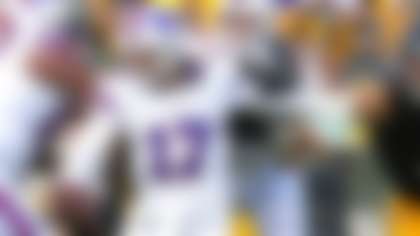Is quarterback play today really superior?
That's what I endeavored to find out, at least partially, by comparing the starting QB for each team today with his counterpart from 25 years ago. With a nod to Paul Zimmerman, a transcendent football writer who compared passers 20 years apart in 2008, I decided to build in a market correction for the proliferation of the passing game between the eras of Dak Prescott and Troy Aikman.
It was a bit complicated, but the QBEA (Quarterback Era Adjustment) shed much light on the '92 elite as contrasted with 2017's projected starters. Further details on the QBEA are provided at the end of this piece. Also, there were just 28 teams in 1992 -- meaning you won't find comparisons for the Panthers, Jaguars, Ravens or Texans, as there was no one to compare those QBs to.
Let's dive in ...
Arizona Cardinals: Carson Palmer (2017) vs. Chris Chandler (1992)
Adjusting Chris Chandler's raw 1992 numbers to what they would have been in 2016 gives him a pretty solid stat line: 65 percent completion rate, 20 touchdowns and 11 interceptions. Much like Carson Palmer, injuries plagued Chandler throughout his career. He only started 13 games in '92 before being replaced by Steve Beuerlein in '93. Chandler was a journeyman QB who ultimately toiled for seven teams and enjoyed a career renaissance in Atlanta in his mid-30s. Sound familiar? Palmer, too, has succeeded in the third stage of his career. Despite the parallels, Palmer has been the more productive and consistent player -- and he's never been a backup.
ADVANTAGE: Carson Palmer
Atlanta Falcons: Matt Ryan (2017) vs. Chris Miller (1992)
Matt Ryan is coming off a brilliant MVP season. Chris Miller came down from a Pro Bowl in 1991 to part-time duty in 1992, making this list by dint of his team-high eight starts. Miller's era-adjusted TD-to-INT ratio is 20:4. Unfortunately, his career was hampered by something we are all too familiar with in 2017: concussions. Miller was no longer a viable starter by the mid-1990s, and he can't compete with a rising star in Ryan. But make no mistake, the guy could play.
ADVANTAGE: Matt Ryan
Buffalo Bills: Tyrod Taylor (2017) vs. Jim Kelly (1992)
While no one ever seems to be totally pleased with Tyrod Taylor, he has, at the very least, been an efficient quarterback for the Bills. He's thrown a mere six interceptions in each of the last two seasons while providing a running dimension that Jim Kelly couldn't. In truth, Kelly was better in previous years, as he threw more interceptions in '92 than in any other season. But his era-adjusted TD-to-INT ratio is a healthy 31:13. Not to mention, in '92, he led Buffalo to a third straight Super Bowl appearance.
ADVANTAGE: Jim Kelly
Chicago Bears: Mike Glennon (2017) vs. Jim Harbaugh (1992)
It's the highly paid quarterback who's hardly started versus the highly paid college coach whose NFL tenure was too short. What an odd pairing. Jim Harbaugh was OK in 1992, throwing one more touchdown than interception in a season that saw Mike Ditka's Bears fall to 5-11 -- though his era-adjusted numbers (17:8 TD-to-INT ratio) look much better. For the record, Harbaugh did start in all five wins while losing only eight. He also led Chicago to the postseason in both 1990 and 1991, while making the Pro Bowl in 1995 for the Colts. Although Mike Glennon's career statistics are superior to Harbaugh's, they represent a much smaller sample size. The tall, lanky quarterback has only started 18 career games and zero the last two years.
ADVANTAGE: Jim Harbaugh
Cincinnati Bengals: Andy Dalton (2017) vs. Boomer Esiason (1992)
If we're talking about Boomer Esiason in his prime, this is a no-brainer. But playing under David Shula for the first time in 1992, Esiason put forth what was easily his worst season as a starter in Cincy. The lefty went 4-7 over 11 starts while posting a career-low 57.0 passer rating -- and that makes this a closer call than you might think. Andy Dalton is an ascending player coming off the second-best campaign of his career, the Bengals' struggles in 2016 aside. Still, I don't want to give too much weight to Esiason's '92 outlier. He did implement Sam Wyche's no-huddle dream on the field, which changed the way offenses in 2017 do business. At the end of the day, I'll take the former league MVP.
ADVANTAGE: Boomer Esiason
Cleveland Browns: Cody Kessler (2017) vs. Bernie Kosar (1992)
It's a youngster heading into his second year with a seemingly limited grip on the starting reins against a banged-up franchise quarterback slowly on his way out of Cleveland. Still, this is an easy nod to the 1992 passer. Bernie Kosar was well into his descent as an NFL starter, a slide that ultimately led to then-Browns coach Bill Belichick cutting ties rather unceremoniously a year later. That said, much of Kosar's decline stemmed from his getting pummeled behind a crappy offensive line. It should be noted that Kosar's era-adjusted completion percentage is 72.8, while his passer rating is 104.0, although he had limited duty in 1992. Here's hoping Kessler receives more than limited duty in 2017. Can't tell if a kid can play if he doesn't get to play.
ADVANTAGE: Bernie Kosar
Dallas Cowboys: Dak Prescott (2017) vs. Troy Aikman (1992)
In 1992, Troy Aikman was in the first year of a four year-run in which he won three Super Bowls and amassed a 10-1 playoff record. And while Dak Prescott's 2016 season was better than any one year in Aikman's tenure, Aikman's era-adjusted 1992 stats are sharp: 4,292 yards, 31 TDs and just 10 interceptions. Prescott's TD-to-INT ratio (23:4) was better, but like Aikman, he wasn't asked to do too much, so the overall production isn't there.
ADVANTAGE: Troy Aikman
Denver Broncos: Trevor Siemian (2017) vs. John Elway (1992)
It's Trevor Siemian versus his current boss, who is all too ready to let another kid he drafted play instead. We'll see if Siemian can ward off the much talked about (though less-seen) Paxton Lynch. Obviously, John Elway wins this deal. That said, 1992 was his toughest year in a Broncos uniform. He missed several games due to injury while trying to gut out a few appearances for a coach (Dan Reeves) he couldn't stand. Reeves didn't exactly incur an orange crush when he drafted quarterback Tommy Maddox out of UCLA in the first round that same year. Elway spent the rest of his career in Denver, while Reeves was coaching the Giants by 1993 ... so what's that tell you?
ADVANTAGE: John Elway
Detroit Lions: Matthew Stafford (2017) vs. Rodney Peete (1992)
One of the easier competitions to weigh here. Rodney Peete never really got over the hump in Detroit, as the Lions' best run of the 1990s came in 1991, when they reached the NFC title game under the direction of Erik Kramer. Even adjusting Peete's 1992 numbers (57.7 percent completion rate, nine TDs, nine INTs) to today (63.3 percent completion rate, 12 TDs, six INTs) doesn't put him in the Matthew Stafford stratosphere. The latter was having a fantastic season until an injured digit derailed the Lions over the last few weeks. Stafford managed to put together a league-high eight game-winning drives in 2016. While Peete put up an impressive 8.0 yards per attempt in '92, he was 2-8 as a starter on a team that was competitive enough to make the playoffs in '91, '93, '94 and '95.
ADVANTAGE: Matthew Stafford
Green Bay Packers: Aaron Rodgers (2017) vs. Brett Favre (1992)
Well isn't this matchup fun: one of the most ballyhooed (and hottest, based on last year's stretch run) quarterbacks in the league against a first-ballot Hall of Famer in his first year as a starter. Cheeseheads can argue about these two all day. Taking the long view, Rodgers has inarguably impressive numbers, like his 45-touchdown, six-pick 2011 season, and his career passer rating of 104.1, currently the best in league history. Ah, but Favre took the Pack to more Super Bowls (two to one) and won more MVPs (three to two). Well, the Favre lovers will have to take one on the chin here, because the certifiable iron man threw a lot of picks early in his career. Favre's era-adjusted '92 stat line would include a 24:9 TD-to-INT ratio and a solid 97.9 passer rating. Which is still well under Rodgers' 2016 marks of 40:7 and 104.2. Yikes.
ADVANTAGE: Aaron Rodgers
Indianapolis Colts: Andrew Luck (2017) vs. Jeff George (1992)
The only thing wider than the 25-year gap between these guys is the gulf between their attitudes. On one end of the spectrum, there's Andrew Luck, who has turned out to be all the Colts organization hoped he would be. Like Luck, Jeff George can claim the distinction of being a former No. 1 overall pick. Unlike Luck, George was considered a first-rate pain in the arse. Owner Jim Irsay had to convince George (with the threat of penalties) to report to training camp; following the 1993 season, he was traded. To this day, George is one of the finest arm talents I've ever seen, but he could have used a bit of Luck's maturity in the early going, when he and the Colts franchise needed it most.
ADVANTAGE: Andrew Luck
Kansas City Chiefs: Alex Smith (2017) vs. Dave Krieg (1992)
Maybe the toughest matchup here. The much-maligned Alex Smith just watched Chiefs brass draft his future replacement. Dave Krieg was replaced following the '92 season, although it's one of those no harm, no foul deals, considering it was with Joe Montana. While Smith has been underrated over the last six years, Krieg was underappreciated for over a decade. The numbers? Krieg's adjusted '92 figures (3,881 yards, 20:8 TD-to-INT ratio, 92.5 passer rating) were extremely close to Smith's 2016 line (3,502 yards, 15:8 TD-to-INT ratio, 91.2 passer rating). They both took their teams to the postseason, only to be bounced in the first game. Krieg was streakier than Smith, but he wasn't afraid to throw deep and, to this point, has superior career numbers.
ADVANTAGE: Dave Krieg
Los Angeles Chargers: Philip Rivers (2017) vs Stan Humphries (1992)
Who doesn't love them some Stan Humphries? Humphries took the Chargers to the playoffs in 1992 and even won a game. Two years later, the Bolts were in the Super Bowl. Humphries was solid and tough, if not sexy. Like Chris Miller in Atlanta, concussions ended his NFL tenure after the 1997 season, which ultimately led to the organization drafting ... you can guess it ... come on ... Ryan Leaf. Philip Rivers has broken nearly every franchise passing record, most of them formerly belonging to Dan Fouts, and is a borderline Hall of Fame player.
ADVANTAGE: Philip Rivers
Los Angeles Rams: Jared Goff (2017) vs. Jim Everett (1992)
Jared Goff's rookie season was marked with potholes, with the former Cal star unable to turn the tables on opponents due to a porous running game, little production from the tight end and haphazard blocking up front. Jim Everett overturned a table on a pesky Jim Rome after being called "Chris Evert" approximately one more time than he wanted. Long criticized for not being tough enough -- and for not pulling the Rams out of their early '90s slump -- Everett has gotten a bad rap. He threw 60 touchdown passes combined in 1988 and 1989, a huge figure for that era. His 1992 campaign was the most efficient of his "down" years in Los Angeles, when he passed for 3,323 yards and 22 scores. Adjusted for the modern era, those numbers would come out to 4,140 yards and 29 touchdowns. Not bad for a down year, huh?
ADVANTAGE: Jim Everett
Miami Dolphins: Ryan Tannehill (2017) vs. Dan Marino (1992)
This article marks the one spot in the universe where I can say something slightly not glowing about Ryan Tannehill and not have some guy with a Bernie Parmalee jersey hammer me on Twitter. While Tannehill continues to progress and should be even better in Year 2 with Adam Gase, Dan Marino is a top-10 all-time QB. Marino's 1992 campaign was one of his last uber-prolific seasons, as he led the league in completions, attempts and passing yards. Oh, and Marino's era-adjusted 1992 line works out to 5,128 yards and 32 touchdowns. Both Tannehill and Marino were expected to start, and lead, in Year 1 -- a big ask in either player's era.
ADVANTAGE: Dan Marino
Minnesota Vikings: Sam Bradford (2017) vs. Rich Gannon (1992)
Nothing reflects what's wrong with (and difficult about) comparing quarterbacks from different eras more than this matchup. Sam Bradford set an NFL record with a 71.6 completion percentage last season, which helped him to a 99.3 passer rating. But what did it all mean? Despite being equipped with one of the top defensive units in pro football, Bradford put up a 7-8 record as a starter. He essentially dinked and dunked his way to that completion mark, too. How can you tell? His 7.0 yards per attempt was below the league average, despite the fact he completed such a high percentage of his passes. While adjusting Rich Gannon's numbers to 2016 still doesn't get him to Bradford's line, Gannon did help Minnesota to an 11-5 record and the NFC Central Division title in 1992. He also won the MVP award and took the Raiders to the Super Bowl in 2002.
ADVANTAGE: Rich Gannon
New England Patriots: Tom Brady (2017) vs. Hugh Millen (1992)
Let's see, it's Tom Brady versus Hugh ... who? Hugh Millen was a standout at the University of Washington who filled a portion of the two-year void between longtime Patriots signal-callers Steve Grogan and Drew Bledsoe. Other tenures crammed in 1991 and 1992 under head coach Dick MacPherson were those of Scott Zolak and Tom Hodson. Millen performed admirably in 1991 but regressed in '92, going 0-7 as a starter, throwing more interceptions than touchdown passes and averaging only 5.9 yards per throw. In a word, the 1992 Patriots were bad. Strange note: Millen was born the day JFK was shot in Dallas. Another note: Brady is the greatest quarterback ever.
ADVANTAGE: Tom Brady
New Orleans Saints: Drew Brees (2017) vs. Bobby Hebert (1992)
No amount of dissecting or adjusting will get Bobby Hebert's numbers anywhere near those of Drew Brees. The former USFL star was solid with the Saints, taking them to their first playoff berth (ever!) in 1987. In case you are wondering, Hebert's 59.0 completion percentage, 3,287 yards, and 19 touchdowns would translate to a 64.6 completion percentage, 4,096 yards and 25 touchdowns in 2016. Brees, meanwhile, is coming off an NFL-record fifth 5,000-yard season.
ADVANTAGE: Drew Brees
New York Giants: Eli Manning (2017) vs. Phil Simms (1992)
Eli Manning might not have enjoyed his finest season -- or any fun boat getaways -- last year, but he did captain the Giants to the postseason. He also enjoyed two of his better campaigns the previous two seasons, and with the additions of Brandon Marshall and Evan Engram, he should be primed for an improved 2017. In 1992, Phil Simms emerged from a quarterback controversy with Jeff Hostetler only to get hurt in early October. He would play one more year in New York -- a damn good one -- but ultimately was on the downside of his career. Manning likely is too, but there was just not enough of Simms' career left to go with the older guy here.
ADVANTAGE: Eli Manning
New York Jets: Bryce Petty (2017) vs. Browning Nagle (1992)
Juxtaposed with Tannehill-Marino, Dalton-Esiason or Prescott-Aikman, this matchup qualifies as a turd sandwich. Ugh. Take your pick. There's Bryce Petty. (Or Christian Hackenberg? Or Josh McCown?) Thrown to the wolves during that Thursday night fiasco against the Dolphins, Petty went down swinging while the Jets looked like they were mailing it in with no stamps. There's one-year starter Browning Nagle, who got his one, big opportunity with Bruce Coslet's Jets. The second-round pick out of WVU threw seven touchdown passes and 17 picks in 13 starts that season. Which might be why he has 14 career starts to his name. Nagle went 4-10. Petty is 1-3, with three touchdown passes and seven interceptions. Moving along.
ADVANTAGE: None
Oakland Raiders: Derek Carr (2017) vs. Jay Schroeder (1992)
Somewhere, a Raiders fans just spit out his whiskey Mountain Dew reading Jay Schroeder's name. Technically I could have used former USC product Todd Marinovich instead. The Schroeder-Marinovich battle followed the Schroeder-Beuerlein controversy, which followed the Jim Plunkett-Marc Wilson debacle ... oh, to hell with it. This is no contest. Derek Carr wins in a landslide and in a black hole. He's the best Oakland quarterback since Rich Gannon was slinging it in 2002 -- or since Ken Stabler was slinging it and winning it all in 1976.
ADVANTAGE: Derek Carr
Philadelphia Eagles: Carson Wentz (2017) vs. Randall Cunningham (1992)
Not a fair fight. Carson Wentz is coming off a rookie year in which he had little to no help. Of course, some folks didn't think Cunningham had anything to work with, either ... other than tight end Keith Jackson, who was gone by 1992 anyway. But he was an established veteran who not only produced one of his better passing seasons in 1992 but rushed for 549 yards -- at 6.3 yards per clip -- and five touchdowns. Like Wentz's 2016, it was an up-and-down year for the electric Cunningham, who was benched in the second half of an important midseason tilt in Dallas. Questions about his attitude started to surface around this time, an area that seems to be a strength for Wentz.
ADVANTAGE: Randall Cunningham
Pittsburgh Steelers: Ben Roethlisberger (2017) vs Neil O'Donnell (1992)
Neil O'Donnell will forever live in infamy, at least among the Steelers faithful. The 1992 season marked his first as the full-time starter, with O'Donnell having wrestled the job away from Bubby Brister and his Southern charm. Said Pittsburgh fans probably don't want to hear this, but O'Donnell was easily the best quarterback the Steelers employed between the Terry Bradshaw and Ben Roethlisberger eras. Bradshaw was a first-ballot Hall of Famer and Roethlisberger will be. O'Donnell managed contests while rarely making game-changing mistakes. In fact, he never threw more than 10 interceptions in a season. He did throw two to one guy in a Cowboys uniform, though.
ADVANTAGE: Ben Roethlisberger
San Francisco 49ers: Brian Hoyer (2017) vs. Steve Young (1992)
So this isn't a contest. Brian Hoyer was smack dab in the middle of his finest NFL season -- averaging over 300 yards per full game started -- when he was hurt last year. Steve Young had perhaps the greatest quarterback of all time sitting behind him on the depth chart in 1992, his first full season as a starter. Young did quite well in Joe Montana's stead. So well, in fact, that he won the NFL MVP award. When washed through the era-adjuster, Young's 1992 numbers are flat-out awesome, providing a glimpse into just how worthy of a Canton bust he is: a 73 percent completion percentage (which would be an NFL record), a 33:5 TD-to-INT ratio and a 119.1 passer rating, two points higher than Matt Ryan's league-leading figure in 2016.
ADVANTAGE: Steve Young
Seattle Seahawks: Russell Wilson (2017) vs. Kelly Stouffer (1992)
Ew. This ain't close. Russell Wilson has won a Super Bowl and been to two, and his career passer rating (99.6) is the second best of all time. Kelly Stouffer was a first-round pick in 1987 who washed out in St. Louis (with the Cardinals, not the Rams), only to be employed as a bridge quarterback between Dave Krieg and heir apparent Dan McGwire (whose brother Mark helped save baseball with the other St. Louis Cardinals). Speaking of bridges, Stouffer once broke his nose after tripping over his own feet and running into his own teammate, pushed his helmet back up, then tossed a deep touchdown pass to Raymond Butler ... all on the same play! It was one of seven career touchdown passes. Seven. That's it. Speaking of breaking, Wilson might breakdance his way into the Hall of Fame.
ADVANTAGE: Russell Wilson
Tampa Bay Buccaneers: Jameis Winston (2017) vs. Vinny Testaverde
This might not be fair, but I am going with the young buck -- er, Buc -- here. Sure, Winston has only played two seasons. But he's been so much more productive and effective than Testaverde was in Tampa. I am considering Testaverde's long career across three decades; after all, he played until he was 44 and threw for over 46,000 yards. The issue is that Winston has already been asked to carry Tampa, something Testaverde was rarely capable of doing. Save for a portion of his time with the Ravens and the halcyon days of 1998 with the Jets, Vinny was never the focal point of his team. Can you say that about Winston, who has handled the responsibility of being the franchise QB? This is as much a vote for Winston's potential as it is reflective of his ability to win the first 10 yards of the sprint.
ADVANTAGE: Jameis Winston
Tennessee Titans: Marcus Mariota (2017) vs. Warren Moon (1992)
Through two seasons, Marcus Mariota appears to be the real deal. Warren Moon had to spend several years in the CFL to earn an opportunity to start at quarterback in the NFL. Moon made the most of it, though, taking the Houston Oilers to the playoffs every year from 1987 to 1993. The '92 campaign wasn't his brightest, as Moon only started 10 games. But adjusting his per-start averages shows precisely how prolific he was in Houston's "Run N' Shoot" offense: 314.1 yards and 2.4 touchdowns * per game*, with a 104.2 passer rating. Love Mariota's development, but it would be difficult for him to match that output at this stage.
ADVANTAGE: Warren Moon
Washington Redskins: Kirk Cousins (2017) vs. Mark Rypien (1992)
Fresh off a sterling 14-2 campaign that culminated in Washington hoisting the Lombardi Trophy, Mark Rypien came plummeting back to Earth in 1992. The Super Bowl MVP played like anything but, getting off to a slow start in what morphed into an erratic follow-up year. His 71.7 passer rating and 17 interceptions don't tell the full story, either. There was also the 24-6 fourth-quarter lead in an important early season game in Phoenix that Rypien helped blow with pick-sixes on consecutive drives. He didn't fare any better in the postseason. By 1994, the organization moved on to first-round pick Heath Shuler (he was worse.) Kirk Cousins is more accurate, more consistent and could be the franchise leader Rypien wasn't able to be. Well, unless John Lynch gets Cousins to come to San Francisco. (Too soon?)
ADVANTAGE: Kirk Cousins
The final tally: Advantage: 2017 QBs, with a score of 14-12-2.
So how did we adjust the players' '92 numbers so that they could be compared to what quarterbacks are doing in today's pass-happy environment? With the help of NFL.com researchers Mark Dulgerian and Jack Andrade, we multiplied 2016 total passing figures by 87.5 percent (seven-eighths) to reflect the jump in teams from 28 in 1992 to 32 now. Next, we took the percentage differences in each category and applied them to the older quarterbacks' '92 stat lines. Not perfect, but it at least helped account for all the new rules and philosophical changes that have bloated quarterback stats in the current era.
The bottom line: Today's passers are slightly better, but when we get to the Pro Bowl, All-Pro, elite level, the old guys more than hold their own. Put another way: Steve Young would be the MVP today, too.












